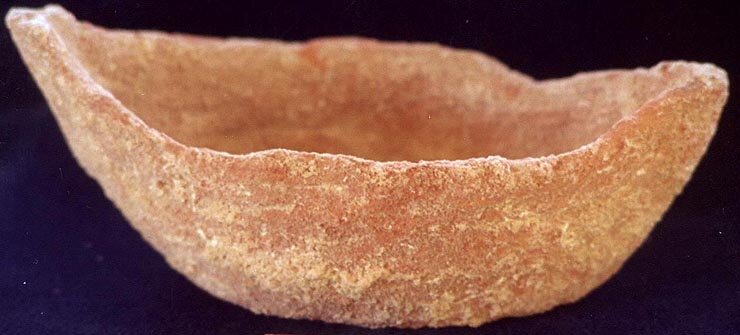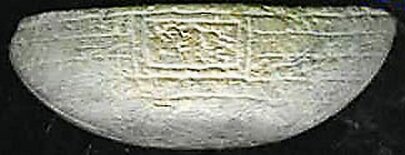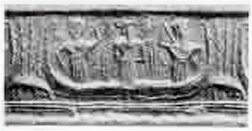Boats of Early Mesopotamia
?

Overview map of ancient Mesopotamia
Mesopotamia housed some of the world's most ancient states with highly developed social complexity. The region was as one of the famous four riverine civilizations where writing was first invented, along with the Nile valley in Egypt, the Indus Valley in the Indian Subcontinent and Yellow River valley in China.
Mesopotamia housed historically important cities such as Uruk, Nippur, Nineveh, and Babylon as well as major territorial states such as the Akkadian kingdom, Third Dynasty of Ur, and Assyrian empire. Some of the important historical Mesopotamian leaders were Ur-Nammu (king of Ur), Sargon (who established the Akkadian Kingdom), Hammurabi (who established the Old Babylonian state), and Tiglath-Pileser I (who established the Assyrian Empire).
"Ancient Mesopotamia" includes the period from the late 4th millennium BC until the rise of the Achaemenids in the 6th century BCE.
Science and technology
Mesopotamian people developed many technologies, among them metalworking, glassmaking, textile weaving, food control, and water storage and also irrigation. They were also one of the first Bronze age people in the world. Early on they used copper, bronze and gold, and later they used iron. Palaces were decorated with hundreds of kilograms of these very expensive metals. Also, copper, bronze, and iron were used for armour as well as for different weapons such as swords, daggers, spears, and maces.
Mathematics
The Mesopotamians used a sexagesimal (base 60) numeral system. This is the source of the current 60-minute hour and 24-hour day, as well as the 360 degree circle. This was also close to the days in a year 360-365. The Sumerian calendar also measured weeks of seven days each. This mathematical knowledge was used in cartography.
Astronomy
The Babylonian astronomers were very interested in studying the stars and sky, and most could already predict eclipses and solstices. Mesopotamian astronomers worked out a 12 month calender based on the cycles of the moon. The origins of astrology probably date from this time.
Religion
Mesopotamian religion is the oldest religion recorded. Mesopotamians believed that the world was a flat disc, surrounded by a huge, holed space, and above that, heaven. They also believed that water was everywhere, the top, bottom and sides, and that the universe was born from this enormous sea.
Agriculture
Food supply in Mesopotamia was quite rich due to the location of the two rivers from which its name is derived, Tigris and Euphrates. Although land nearer to the rivers was fertile and good for crops, portions of land further from the water were dry and largely uninhabitable. This is why the development of irrigation was very important for settlers of Mesopotamia. Other Mesopotamian innovations include the control of water by dams and the use of aqueducts.

The Mesopotamians used three types of boats: wooden boats with a triangular sail, the turnip or Guffa boat which was shaped like a tub, made of reeds and covered with skin, and the kalakku which was a raft of timbers supported by inflated animal skins.
Despite advances in the archaeology of seafaring around the world, the ships and boats of Mesopotamia remain elusive. The absence of their remains combined with a Euro-centric view of maritime developments has left a gap in our knowledge of the cradle of civilization.? The little information at hand is currently limited to iconography and texts.
Representations of Mesopotamian boats are found on seals, in reliefs, and as models. Usually these lack definitive details that would enable fuller understanding of the involved technologies. Resultant studies such as Quall?s Boats of Mesopotamia Before 2000 B.C., and de Grave?s The Ships of the Ancient Near East (c. 2000-500 B.C.), contribute only to our theoretical understanding of Mesopotamian vessels.
Mesopotamian texts with lists of boat parts and materials can lend themselves to increased knowledge of watercraft, yet these texts are poorly understood. In the early days of Assyriology few details of boat building in antiquity were known.? Thus, scholars relied upon the only information they had available: modern boat-building techniques.
Normative modern boat-construction involves the frame-first method. In this, planking is fastened to a pre-erected framework of timbers.?? This process is the reverse to that used in antiquity. Studies of ancient shipwrecks over the past several decades have revealed that ancient boats were built "shell first." In this, the planking was first assembled as a shell and then the internal framework added. The shell-first technique was common throughout the ancient world, and it survives in areas where traditional methods have yet to give way to modern construction practices.
The major study concerning the watercraft recorded in Mesopotamian texts is Wasserfahrzeuge in Babylonien nach ?umerischen-Akkadischen Quellen by Armas Salonen. Published in 1939, this work has become the seminal source for the interpretation of Akkadian and Sumerian boat texts. The Chicago Assyrian Dictionary relies on Salonen?s work for boat and ship terms, and in archaeological concerns his work is an important reference. His interpretations, however, are flawed as Salonen used modern frame-first building Iraqi boat construction as a basis for his analysis. This method appears along the Indian Ocean littoral only after the arrival of the Portuguese in the late fifteenth century.? Thus, by interpreting ancient boat texts using the frame-first method as a guide, scholars produced inaccuracies that are now ingrained in the corpus of our knowledge of the languages and technology of the ancient Near East. "The Boatbuilding Sequence in the Gilgamesh Epic and the Sewn Boat Relation." - Ralph K. Pedersen, Nautical Archaeology Program Texas A&M University
A Kuwaiti site has yielded 7000-year-old bitumen slabs thought to be from a seafaring vessel. If the interpretation of the material is correct, the discovery pushes back physical evidence of boats by more than 2000 years and sheds light on what later became trading routes linking two ancient civilizations: those of the Indus River valley and Mesopotamia.

The British Archaeological Expedition to Kuwait
It has been speculated that vessels made of reed-bundles, coated with bitumen, were among the region's earliest boats. This was believed because later vessels are known to have been made that way, and also because reeds and bitumen are the commonest natural resources found in Mesopotamia which are suitable for that purpose. Similar vessels were used until recently in the marshes of Southern Mesopotamia. The bitumen waterproofs the vessel, and also inhibits the growth of aquatic plants and animals, which slow the vessel down.
The evidence from H3 shows that such vessels were indeed in use, and that they were venturing beyond the river system, into the open sea. For the first time, we have a clear indication of how goods and people moved between the Arabian Gulf and Ubaid Mesopotamia at this very early date.
Bitumen slabs

The outside has barnacles, showing that the slabs have been immersed in sea water for a number of months.
Our evidence comes in the form of small slabs of bitumen, which have reed impressions on one side and barnacles on the other. Over 50 such pieces have now been found at H3 (Carter and Crawford 2002).
Most pieces were found discarded in the the chambers, but some were deliberately stored. It is known from more recent sources that it was customary to chip the bitumen off old vessels, to keep the material for recycling. We believe that this practice explains the presence of the slabs at H3.
Comparable bitumen slabs, from Bronze Age sea-going boats, are known from Ra's al-Jinz, Oman (Cleuziou and Tosi 2000). The H3 examples are around three thousand years older.
The bitumen is not pure, but has been deliberately mixed with lime and chopped organic matter, among other ingredients.
A similar mixture is known from the Ras al-Jinz bitumen slabs. The practice changes the density of the bitumen, as well as it adhesive properties and flexibility.
Although the boat-building technology appears to be Mesopotamian in origin, we do not know whether the vessels were built or crewed by individuals from Arabia or Mesopotamia. One of the most interesting facts emerging from our specialist studies is that the bitumen appears to have come from a local source, at Burgan, in southern Kuwait.
The Model Boat

The model was found tucked against a wall near the entrance of Chamber 15.
It was a very exciting discovery.
Although it appears to have been made in the Arabian Gulf ceramic ware, such models are so far only known from Ubaid sites in Mesopotamia. We do not know its purpose, if any. Perhaps it had protective significance for the Stone Age mariners of H3.

An Ubaid 3 period model boat from Tell Mashnaqa (northeast Syria) showed similar lines descending from the prow and stern, though these were painted, not incised. The Mashnaqa model was also interpreted as a reed-bundle boat, though it was a river-boat rather than a sea-going vessel.
We do not know if the flat bottom of the H3 boat reflects the actual shape. It may simply be so that the model can sit flat on the ground, or perhaps it represents the appearance of the vessel in the water.

The boat disc from H3 (Picture by G. Williams)During the 2002 season another very interesting artefact was found. It was made out of a sherd taken from a broken, painted pot. The design, which was originally the edge of a radial pattern typical of Ubaid pottery, has been deliberately scraped off in places to make a new motif.
It now resembles a boat with two masts. In fact, if we accept that this is a boat representation, it is probably a single mast, made of two poles lashed together at the apex. This construction is known as a bipod mast, and it was used in vessels which lacked a frame strong enough to support the socket of a single mast (Vosmer 2000: 240).
There has been much debate over whether the art of sailing had been developed by the Ubaid period (Strasser 1996; Bourriau and Oates 1997). This find suggests that it had been.
Sumerian Seals

Cylinder Seal Showing A God in A Boat on the River
An early steatite seal showing a god in a boat with a river scene of reeds and plants, birds or chevrons, star of divinity, three dots and an early inscription in a panel that is turned 90 degrees.The script is nearly pictographic, and the short, wide seal form is more characteristic of Jemdat Nasr than the Dynastic period. The engraving style is also in a Jemdat Nasr wheel-cut style. Perhaps this has a later, added inscription, or it could be a very early inscribed seal from late Dynastic I or early Dynastic II period.

Although the sun god Utu-Shamash, and other gods as well, was said to travel the heavens in his sacred boat, this naturalistic scene is more likely a legend of southern Sumeria where the land had more waterways. There are two prominent boat myths from this region, and the first is more likely the subject of this seal. Enki, the water god, was the patron god of Eridu, the southernmost Sumerian city and one of the most ancient. It is said in the Sumerian myth of the building of Enki?s temple in Eridu, the so called ?sea-house?, that after its completion Enki journeyed by boat to Enlil?s temple in Nippur to obtain the blessing and approval of the king of the gods. The other famous boat myth of this region concerns the city of Ur and its patron god Nanna, the moon god. Enlil saw the maiden goddess Ninlil and lusted after her. She rebuffed his passsion, claiming innocent youth, so Nanna lured her to a boat on the Euphrates, where he raped her and conceived Nanna. Horrified at this breach of morality the other gods banished Enllil to the underworld for his crime, and we see that even the ?King? of the gods is subject to law and morality. Both of these myths place the seal in southern Sumeria and hint that it is very early in date.
Mesopotamian flood stories
The majority of modern Biblical scholars accept the thesis that the Biblical flood story is linked to a cycle of Assyro-Babylonian mythology with which it shares many features. The Mesopotamian flood-myth had a very long currency?the last known retelling dates from the 3rd century BCE. A substantial number of the original Sumerian, Akkadian and Assyrian texts, written in cuneiform, have been recovered by archaeologists, but the task of recovering more tablets continues, as does the translation of extant tablets.
The earliest of these extant tablets, the epic of Atrahasis, can be dated by colophon (scribal identification) to the reign of Hammurabi's great-grandson, Ammi-Saduqa (1646?1626 BCE). Written in Akkadian (the language of ancient Babylon), it tells how the god Enki warns the hero Atrahasis ("Extremely Wise") of Shuruppak to dismantle his house (which is made of reeds) and build a boat to escape a flood with which the god Enlil, angered by the noise of the cities, plans to wipe out mankind. The boat is to have a roof "like Apsu" (the underworld ocean of freshwater of which Enki is lord), upper and lower decks, and must be sealed with bitumen. Atrahasis boards the boat with his family and animals and seals the door. The storm and flood begin. Even the gods are afraid. "Bodies clog the river like dragonflies". After seven days the flood ends and Atrahasis offers sacrifices. Enlil is furious, but Enki, the friend of mankind, defies him - "I made sure life was preserved" - and eventually Enki and Enlil agree on other measures for controlling the human population. The story also exists in a later Assyrian version.
Against the king the small ones it (Kur) hurled,
Against Enki, the large ones it hurled;
Its small ones, stones of the hand,
Its large ones, stones of . . . reeds,
The keel of the boat of Enki,
In battle, like the attacking storm, overwhelm;
Against the king, the water at the head of the boat,
Like a wolf devours,
Against Enki, the water at the rear of the boat,
Like a lion strikes down.
Sumerian Stone Votive Boat ? Noah?s Ark

A steatite votive boat with a early, linear cuneiform inscription on the side. This is a wide river boat like the Mesopotamian freight boats and quite unlike the more delicate, elongated marsh boats of the lower delta. Similar boats appear on many Sumerian and Babylonian sculptured panels. These boat carvings both represent the real boats of daily commerce and fishing in this watery land, and the divine boats of the Gods. Note should be made of the construction with wide planks in caraval fashion. In going to the land of the Gods to seek eternal life, the semi-divine hero Gilgamish needed to travel in the boat of Urshanabi, boatman of the Gods. To touch the surrounding waters was death. This also likely relates to Chaeron and his boat for crossing the river Styx to the Land of the Dead in ancient Greece, and to the funerary boats of ancient Egypt. Boats were magical vehicles for entering the spiritual world around the world. Sumerian Dynastic Period, 2500-1900 BCE. 112 mm long x 41 mm wide x 36 mm tall.
This is the kind of boat that would have been Noah?s Ark.
Enki ("lord of the earth") was a deity in Sumerian mythology, later known as Ea in Babylonian mythology, originally chief God of the city of Eridu.

The name Enki is misleading because he was god of the waters and not of earth. The exact meaning of his name is not sure: the common translation is "Lord of the Earth": the Sumerian en is translated as a title equivalent to "lord"; it was originally a title given to the High Priest; ki means "earth"; but there are theories that ki in this name has another origin, possibly kig of unknown meaning, or kur meaning "mound". The name Ea is of Sumerian origin and was written by means of two signs signifying "house" and "water".
Enki was the deity of crafts, water, intelligence and creation.
The main temple of Enki was called ?-engur-a, the "house of deep waters"; or ?-abzu, the "house of Abzu", the under ground area of sweet waters(most probably the sumerians explanation of groundwater). It was in Eridu, which was then located in the wetlands of the Euphrates valley not far from the Persian Gulf. He was the keeper of the holy powers called Me, the gifts of civilised living.











